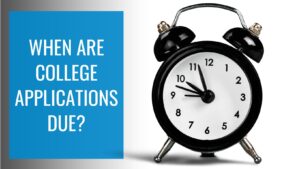Imagine this: You’ve spent months perfectly crafting your college applications and are anxiously waiting for your first set of admissions decisions to arrive. When you receive an update from one of your top schools, you rush to check it. Instead of a cheery acceptance letter or even a denial, however, you find that you’ve been deferred (or waitlisted). What does this mean? Is being deferred better or worse than being waitlisted? What should you do in response to a deferral or a waitlist decision?
Rozhodnutí o odkladu nebo zařazení na čekací listinu může být pro nadějné studenty skličující a ve společnosti Solomon Admissions Consulting chápeme, jaký dopad může mít taková zpráva na vaši studijní cestu. Stejně jako ve světě hazardních her s kasiny, jako je zde: https://online-casinocz.com/synot-games/, kde se mohou objevit nejistoty, vyžaduje procházení těmito okamžiky strategický přístup. Zaprvé je nezbytné si uvědomit a zpracovat emoce, které s takovým rozhodnutím přicházejí. Stejně jako v hazardní hře nemusí výsledky vždy odpovídat našim očekáváním. Věnujte chvíli zamyšlení nad svými cíli, přehodnoťte své možnosti a zvažte alternativní cesty, které by mohly vést k úspěchu. Pamatujte, že rozhodnutí o odložení nebo zařazení na čekací listinu neznamená konec cesty; je to spíše okamžik, kdy je třeba se znovu zamyslet a přistoupit k situaci s odolností a odhodláním. Jak v akademické sféře, tak v oblasti hazardních her spočívá úspěch často v přizpůsobivosti a promyšleném herním plánu.

Deferred vs. Waitlisted
What do these decisions mean?
Colleges and universities may render a deferral or waitlist when an immediate decision on your application is otherwise not available. While deferrals and waitlists are two distinct things, both situations will delay the final decision of your application for admission.
If you receive a deferral letter, you likely applied to your school through its Early Action or Early Decision plan(s). The school could not provide a clear admit or deny decision during that time frame, likely because they needed more time or information about your application to reach a final decision. As a result, they opted to defer your application for later reconsideration with the pool of regular decision candidates. If you were deferred, it likely means your application wasn’t quite strong enough to be a clear early admit but had promise. By waiting to evaluate your application with the usually larger, regular applicant pool, the school can better assess how you might compare. Luckily, a deferral frees you from any existing obligations to the school that might have existed due to Early Action or Early Decision policies, allowing you to reassess and prioritize other pending applications. You can continue these efforts while waiting to hear a final determination, likely around the same time most regular decision applicants hear back, or by May 1st at the latest.
If you receive a waitlist letter, the school was unable to make an immediate offer of admission but decided you had enough potential to be considered for a seat, only if a space becomes available. A school may add students to the waitlist because they simply do not have enough seats in their class to admit excellent students. As applicants sort through admissions decisions and matriculate, a waitlist offers schools a ready list of students who would be next in line to be admitted if space remains. Additionally, schools may invite students to go on the waitlist who just miss the mark in being easy to admit. This can be due to standardized tests, grades, and other qualifications that are not on par with the standards set for admission. Since waitlist activity is greatly dependent on the actual number of seats that remain in an incoming class, applicants will not be admitted before the May 1st deadline for college decisions.
Is it better to be deferred or waitlisted?
Understanding your odds in either a deferred or waitlist scenario requires some knowledge of how colleges and universities actually utilize such lists, if at all.
A 2019 State of College Admission report from the National Association for College Admission Counseling (NACAC) found that, for the Fall 2018 admissions cycle, 43% of schools reported using a waitlist. Among highly selective schools, utilizing a waitlist was far more likely, with 82% of most selective institutions reporting usage. Schools may rank their waitlist, meaning those ranked near the top would be first considered for any existing seats. On average, schools accepted 20% of all students who remained on their waitlist; however, waitlist admission rates at highly selective institutions were far lower at 7%. Recent trends in college admissions have indicated that waitlists are getting longer with schools opting to add more applicants to their waitlist as an enrollment strategy.
The landscape for deferrals offers variety as well. Only schools that offer Early Action or Early Decision rounds may utilize deferred admission, although not all do. Additionally, each school will have a different approach to how they defer admission, with some schools only deferring a very small percentage of early applicants while others deferring all students to the regular pool who were not offered admittance. Carefully read the information provided on the deferral letter to see if any related data was provided and if not, consider researching online or contacting the school for this information.
In both scenarios, you receive a second chance—more or less—to be in continued consideration of the school. Both are better than denials and, with some additional effort, you can boost your chances of being admitted.
A deferral, however, provides you the opportunity to be reconsidered before your application has reached a full review and decision. While waitlist offers are only contingent upon space remaining in the incoming class, deferred admission still allows you to be in the running before the admissions cycle is near its conclusion. A deferred applicant will be considered again before any reconsideration is provided to a waitlisted applicant. As such, being waitlisted at a school is worse than a deferral because the institution has decided not to admit you unless other applicants decline their admission offer and seats become available. At highly selective schools where yield (or the percentage of students who enroll at the school after being admitted) rates are very high, this is very unlikely.
What should you do following a deferral or waitlist letter?
In either scenario, gather information about the specifics of the school’s deferral or waitlist policy. If you need to accept or reject your waitlist status, make sure to confirm that before the deadline.
Additionally, assess the areas of your application that could be strengthened or otherwise updated. Applicants are deferred or waitlisted because there wasn’t adequate information to easily admit them. A higher standardized test score, an updated final transcript, and resume, or additional honors and recognitions could help add more credence to your candidacy for admission. Sending a letter of continued interest to the school or your college admissions counselor might also benefit your application as schools want to admit students who are passionate and eager about attending their institution. If your school allows updates to be submitted during this period, utilize the opportunity to update your application with these types of additional material. Be concise and highlight what’s most relevant—being overbearing and contacting your school too much can have an undesired effect.
As in many areas, it’s always a good idea to get a professional opinion. We have one of the largest and most experienced teams of admissions consultants in the industry, and we’d love to help you. Contact us today!

All of our blog posts are written by Former College Admission Officers who serve as members of our admission consultant team.


